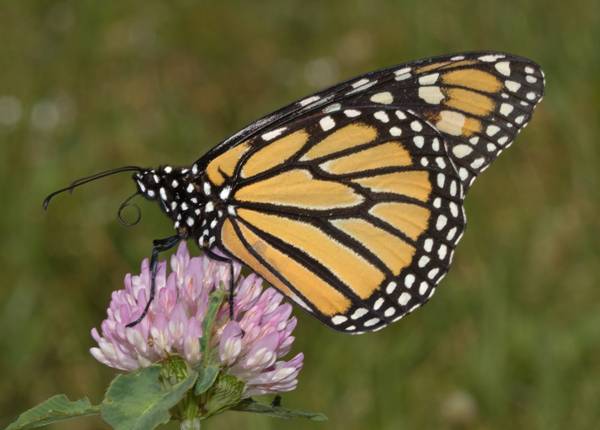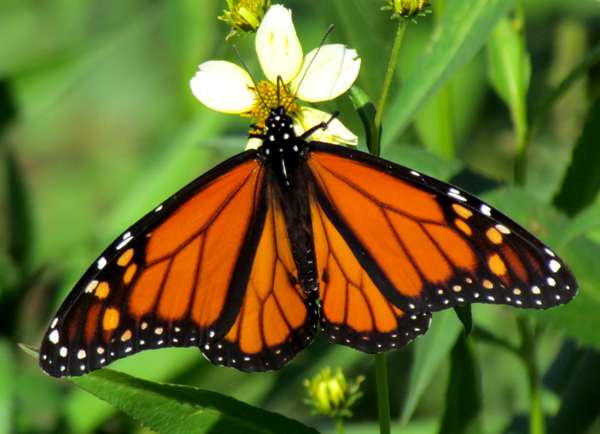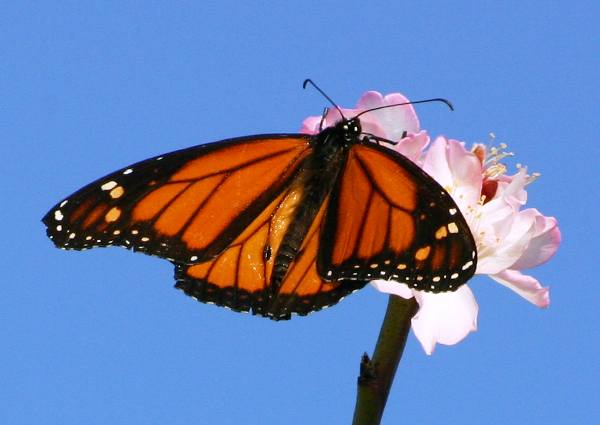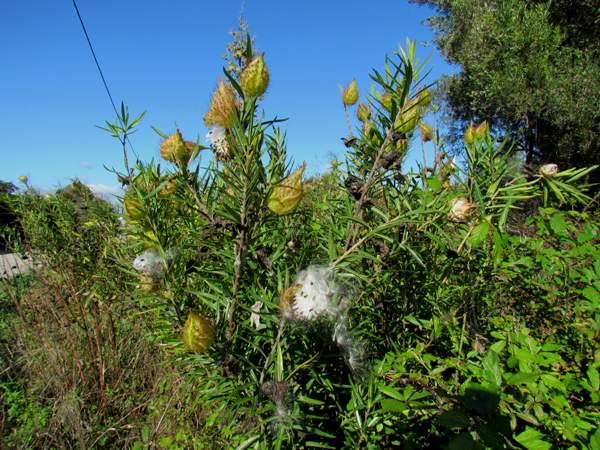Monarch Butterfly - Danaus plexippus
Phylum: Arthropoda - Class: Insecta - Order: Lepidoptera - Family: Nymphalidae

With climate change this lovely American butterfly may be finding the stormy spring weather a major problem as it migrates on wind currents thousands of miles across the Atlantic Ocean to Europe. In parts of southern Europe, notably Madeira, the Canary Islands and the Azores, Monarch butterflies are resident; there may also be resident colonies in the Algarve region of Portugal.
The Monarch belongs to a subfamily known as the milkweed butterflies.

With a wingspan of typically 9 to 10cm (the males somewhat larger than the females), the large and conspicuous butterflies are easily identified by the brilliant orange background of their wings and the black patterning. Females have somewhat broader black veining than males. A female, with wings closed, is pictured above and a male is shown below it.
Distribution
The Monarch is probably North America's best known butterfly, famous for its long-distance migration northwards as far as Canada in the spring and then southwards again in the autumn (the fall!).
Individual butterflies do not complete the entire migration, as for most of them their adult lifespan (as winged insects, that is) is limited to no more than one or two months.
Only very occasionally are Monarchs reported from southern Britain, but they are more commonly seen in the Scillies and the Chanel Isles. The fine specimen shown above was photographed in an old almond grove in southern Portugal.
Lifecycle

Females lay eggs in spring and summer during the migration journey, and in this way new Monarchs are able to take up the baton. The foodplants of the larvae include various milkweeds and silkweeds (including the Bristle-fruited Silkweed Gomphocarpus fruticosus pictured below) as well as daisies (Asteraceae), Wild Carrot (Daucus carota), thistles and teasels. The eggs hatch in about four days, and the yellow-and-black caterpillars feed on the host plant for about two weeks before pupating. Two weeks later the adult butterfly emerges.

Bristle-fruited Silkweed Gomphocarpus fruticosus is a larval foodplant of Monarch butterflies in the Algarve region of southern Portugal
The brightly coloured Monarch has two valuable defence mechanisms: it tastes awful (the degree depending on which host plant it fed on during the larval stage) to most birds that would otherwise prey upon it, and it contains strong toxins. (Milkweeds are poisonous, and from them the Monarch accumulates cardenolides (cardiac glycosides). Milkweed species vary greatly in their cardenolide content, and so also, therefore, do Monarchs butterflies. (Milkweeds do not occur in the wild in Britain.)
Reduction in forest cover is a major threat to the survival of the Monarch, whose numbers are reported to have plummeted in recent years.
Studying butterflies and moths...
Excited at the prospect of flyfishing? So are we, and we're pretty sure you would find the Winding River Mystery trilogy of action-packed thrillers gripping reading too. Dead Drift, Dead Cert, and Dead End are Pat O'Reilly's latest river-and-flyfishing based novels, and now they are available in ebook format. Full details on our website here...
Buy each book for just £4.96 on Amazon...
Please Help Us: If you have found this information interesting and useful, please consider helping to keep First Nature online by making a small donation towards the web hosting and internet costs.
Any donations over and above the essential running costs will help support the conservation work of Plantlife, the Rivers Trust and charitable botanic gardens - as do author royalties and publisher proceeds from books by Pat and Sue.
